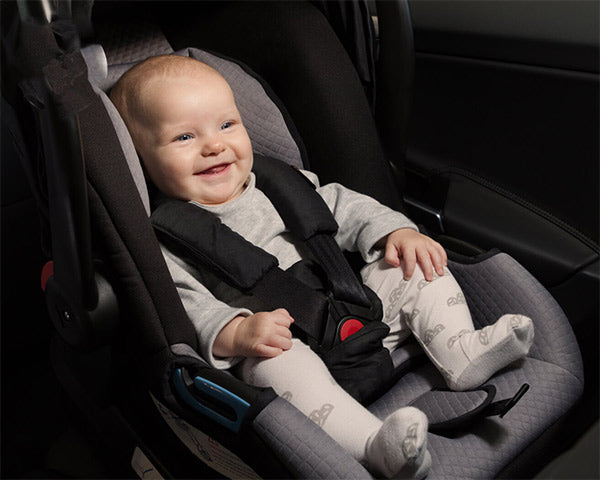People are paying more and more attention to the safety of children when traveling. Many families with babies, or families who are about to have babies, have begun to purchase and use child safety seats.
According to statistics, the current age of purchasers of safety seats is mainly concentrated between 25 and 35 years old, and the purchasing channels are mostly online. Therefore, a very important question arises: how to install the safety seat after buying it?
Can safety car seats be installed in the Co-pilot position?
First of all, you need to know that the safety car seat must not be fixed in the front passenger seat, but can only be installed in the back row. Because in the event of an emergency, the airbag will explode and deploy within 0.05 seconds.
Equivalent to a speed of about 300 km/h, the instantaneous impact can be fatal to children. This is no joke, just look at the safety tips on the passenger vanity mirror.
So how to install it in the back row? Let me tell you in detail next.
There are three types of interface fixation for child safety seats, namely ISOFIX interface fixation, LATCH interface fixation, and seat belt interface fixation. Presumably, before you choose a baby safety seat, you already know what kind of interface your car has, then choose a safety seat with the matching interface. I will talk about them separately below.

1. ISOFIX interface
The first one ISOFIX interface fixation: the full name is "International Standards Organization FIX". This child safety seat fixation system is a standard formulated and implemented in Europe in 1990. It creates a rigid connection between the child's safety seats and the car, making it more secure.
Since it is a standard set by Europe, most European models have ISOFIX child safety seat interfaces as standard configuration. At the same time, models produced in joint ventures with Europe also have the ISOFIX child safety seat system fixed interface logo. The background of its birth was that many people at that time could not install and use child seats correctly.

The ISOFIX interface fixation method is very simple. Because the ISOFIX interface is already installed in the car when it leaves the factory. When installing, you only need to find the ISOFIX interface position on the rear seat, and then insert the safety car seat fixing buckle into the interface.
However, special attention should be paid to the fact that after plugging in the ISOFIX interface, you still need to check whether there are any empty bits by swinging left and right.

In addition, if the child safety seat you purchased is also equipped with a support leg fixing bracket, you need to contact and fix the support legs under the child safety seat with the bottom of the car. This support leg anti-roll device can make the safety seat Stronger, reducing forward displacement during a collision, thereby increasing safety.

2. LATCH interface
The second one is LATCH interface fixation: the full name is "Lower Anchors and Tethers for Children". It was officially used in the United States on September 1, 2002. All models are required to be equipped with a LATCH child safety seat interface.
LATCH uses three fixed points, two of which are at the connection between the seat cushion and the seat back, and the third is at the connection point between the seat cushion and the seat back. There will be a hook logo behind the seat headrest.

Compared with the ISOFIX interface, the LATCH interface has an additional top or bottom fixed point. First, find the fixing device under the rear seat, place the seat on the back seat, insert the connecting rod into the fixing device, then grab the front of the seat, push the locking connecting rod forward forcefully, and confirm whether the connection is firm. Finally, just connect the top strap to the LATCH fixing ring on the back.

In terms of compatibility, ISOFIX is compatible with LATCH, which means that those with ISOFIX interfaces can also be equipped with seats with LATCH interfaces, but those with only LATCH cannot use child seats with ISOFIX interfaces. When choosing a safety seat Be sure to pay attention!
3. Seat belt fixation method
Some cars do not have a dedicated interface for safety seats. In this case, you can only use the seat belt on the car to fix it. For example, on older models without an ISOFIX interface, you can only choose this fixing method.
It seems that the seat belt fixation method has very good compatibility and is suitable for various models. But it should also be noted that there are still some safety seats that cannot be fixed with seat belts.
Seat belt fixation methods are cumbersome to install and have a high error rate. When installing, please note that the seat belt must be tightened slowly after passing through the seat. Pay special attention to tightening the seat belt that runs through the seat.
Therefore, I suggest that when you install it for the first time, it is best to ask customer service for installation videos and instructions to prevent installation errors.
Summary and recommendations
But if you have enough budget and there is an ISOFIX interface in the car, I suggest you give priority to the safety car seat with an ISOFIX hard connection. Remember not to be fooled by the merchant and choose ISOFIX soft connection. The safety of the two is incomparable.
But if your model does not have an ISOFIX interface, or you have a low budget, it is recommended to choose a safety car seat with a seat belt fixed.
Safety and stability: ISOFIX>LATCH>Safety belt fixation
Installation convenience: ISOFIX > LATCH > Seat belt fastening
Cost-effectiveness: Car seat belt fixation>LATCH>ISOFIX

















